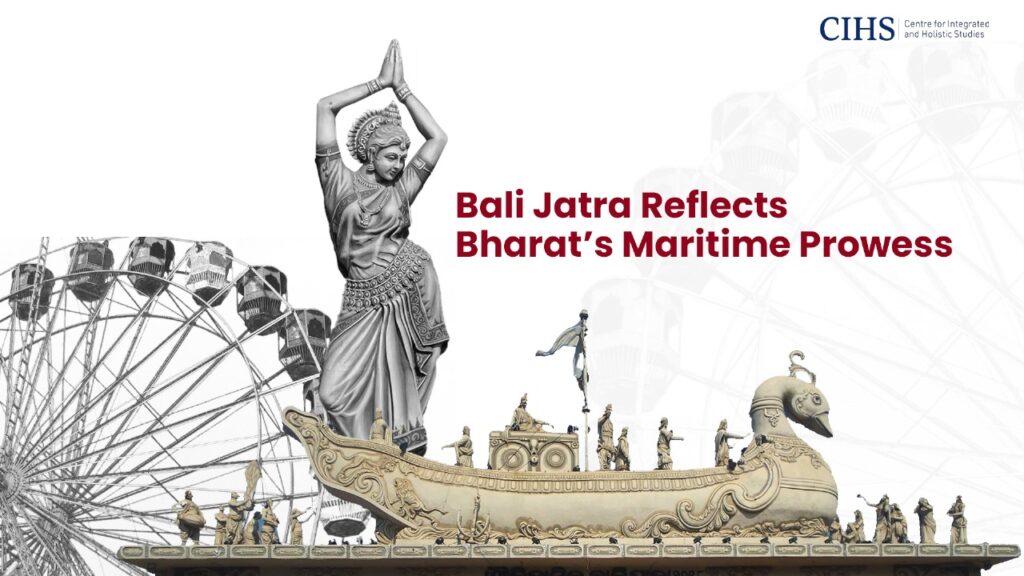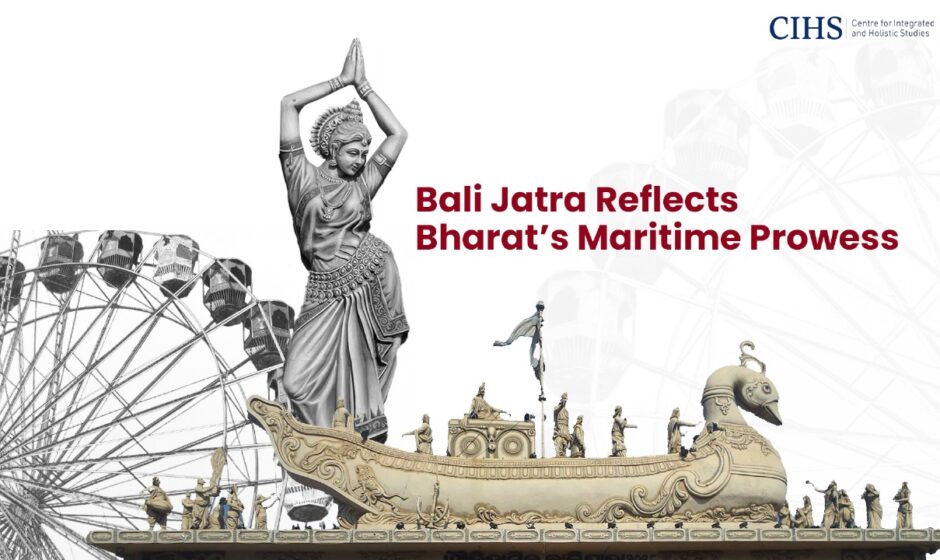India and Southeast Asia share civilizational connect, maritime and cultural heritage that’s now dubbed as Global South.
Dr Aniket Pingley
Connections between India and Southeast Asia go back more than two thousand years, shaped by vast waters of Indian Ocean. These seas were not barriers but bridges, linking ports of ancient India with the islands and coastal regions of what we now call Southeast Asia.

Merchants, monks, artisans and travelers carried more than goods; they carried stories, languages, faiths and practices. Over time, these exchanges left enduring marks on societies from Sumatra to the Malay Peninsula and beyond. In many ways, Southeast Asia became a mirror that reflected civilizational outreach of Bharat.
Trade was the most visible layer of this relationship. India exported textiles, spices, beads and ivory while importing gold, tin, camphor and exotic wood from Southeast Asia. These exchanges were never limited to commerce alone. Maritime routes were also pathways for ideas.
Ramayana and the Mahabharata were retold in local languages; Sanskrit and later Pali shaped courts and religious practices and Indian temple architecture inspired monuments from Angkor in Cambodia to Borobudur in Indonesia. The very names of places such as Yogyakarta, Ayutthaya and Srivijaya testify to these cultural flows.
These interactions reveal how India’s influence went beyond its borders helping to form cosmopolitan societies in Southeast Asia that were both rooted in local traditions and open to outside influences.
Diplomatic and political exchanges played an important role. Rulers in Java, Bali and Sumatra often drew on Indian ideas of kingship, legitimizing their authority through symbols and rituals derived from the subcontinent. The legend of King Airlangga of Java, for example, shows how Indian epics and models of governance were woven into local traditions [5].
Similarly, in Malay Peninsula, early polities combined maritime trade with cultural borrowing from India, laying the foundations for the region’s lasting connections with the subcontinent [7].
These layers of connection commercial, cultural, religious and political formed a civilizational network that is now increasingly referred to as “Global South.” India’s historic outreach demonstrated how societies of South could link with each other, exchange resources, and build hybrid cultures without external domination. This perspective is particularly important today as countries of Asia, Africa, and Latin America seek greater cooperation outside the traditional frameworks of the West [7].
Bali Jatra: Memory of the Ocean Voyages
Odisha, known as Kalinga in ancient times, was a formidable maritime power. Its strategic location along Bharat’s eastern coast made it a hub for trade and cultural exchange. Major ports like Tamralipti, Palur and Manikapatna were bustling centres of commerce, facilitating movement of goods and ideas between India and Southeast Asia.
It is in this context that festival of Bali Jatra (Baliyatra), celebrated in Cuttack, Odisha, hold such significance. Literally meaning “voyage to Bali,” the festival commemorates the journeys once undertaken by Sadhabas or Odia merchants, who sailed across the Bay of Bengal to trade with Java, Bali, Sumatra and other parts of Southeast Asia [1][2].
During full moon of Kartik Purnima every year, families in Odisha still set afloat small boats made of banana bark, paper, or cork, symbolizing vessels that once braved seas. The Balinese celebration of Nyepi, Hindu New Year, bears similarities to rituals of Kartik Purnima in Odisha. Both festivals involve offerings to the gods, prayers for prosperity and rituals closely tied to agricultural and maritime cycles.
The practice is more than a regional ritual; it is a living archive of India’s maritime past. Bali Jatra reminds us that Indian Ocean trade was not incidental but central to Bharat’s engagement with Southeast Asia. At its height, these voyages established a dense web of relationships that enriched both sides.
For Southeast Asia, Indian traders brought goods and technologies that supported local economies. For India, the voyages opened access to new markets, resources and cultural influences. The festival, therefore, is not only about nostalgia but also about acknowledging an interconnected past.
Today, Bali Jatra has grown into one of the largest open-air fairs in Asia, attracting millions of visitors [3]. It showcases not just Odisha’s heritage but wider story of India’s role in maritime Asia. The festival includes cultural performances, food, handicrafts, and exhibitions that highlight the living traditions of seafaring communities.
It also increasingly serves as a site of cultural diplomacy, inviting participation from Southeast Asian countries whose histories are tied to these voyages.
Contemporary Relevance & Policy Play
The significance of Bali Jatra does not end with heritage. It has clear implications for policy and diplomacy in the present. India and ASEAN today are strategic partners, cooperating in trade, security and cultural exchange. Yet for these partnerships to deepen, they need narratives that bind them beyond statistics. Bali Jatra provides one such narrative, rooted in shared history and civilizational connect.
For Bharat’s policymakers, the festival is an example of India’s civilizational diplomacy. The presence of diplomats and foreign representatives at recent Bali Jatra celebrations shows growing recognition of its potential [3].
By inviting Southeast Asian leaders, academics, and artists to participate in the event, India can use the festival to create dialogues that are both cultural and strategic. Such engagements could align with forums like the Delhi Dialogue and ASEAN–India summits [8], making cultural heritage an integral part of foreign policy.
For Southeast Asian nations, acknowledging festivals like Bali Jatra opens space to emphasize shared heritage while respecting national diversity. Countries such as Indonesia and Malaysia, where Indian cultural imprints remain visible, can view these connections not as relics of the past but as foundations for renewed cooperation.
Policy research papers from think tanks such as Institute of Strategic and International Studies Malaysia already suggest that cultural diplomacy can strengthen the Comprehensive Strategic Partnership between India and Malaysia [6]. Similarly, Indonesian scholars point to the shared legacy of figures like King Airlangga as a reminder of intertweaved histories [4].
For the academic community, Bali Jatra offers a platform for dialogue on the meaning of the Global South. As scholars note, the Global South is not only about political alignment but also about shared histories of exchange and resilience [7]. The festival exemplifies how the societies of Asia were linked long before colonial interventions, and how they might cooperate today in more equal terms.
Closing Remarks
Bali Jatra is more than a fair or a festival. It is a reminder of the voyages that once tied India i.e. Bharat to Southeast Asia and shaped a world of shared prosperity. It highlights India’s role in the history of the Indian Ocean and its relevance for the contemporary project of building solidarity within the Global South. By reviving and reinterpreting this tradition, India and ASEAN are creating not only cultural understanding but also new avenues of partnership.
As the world undergoes geopolitical shifts, Global South seeks stronger voices and deeper networks. India’s cultural diplomacy, when rooted in traditions like Bali Jatra, offers both authenticity and resonance. For diplomats, policymakers, and scholars, engaging in these living traditions provides a bridge between history and strategy. Just as the Sadhabas once launched their vessels toward distant shores, today’s leaders are launching initiatives that carry forward the spirit of connection, cooperation, and shared destiny.
(Author is an accomplished computer scientist, educator, and holds expertise in media content strategy)
References
1. Dash, R. N., “Bali Jatra: A Festival of Odisha’s Ancient Maritime Trade,” Odisha Review, November 2017. [Link]
2. Press Information Bureau (Ministry of Culture, Government of India), “Bali Jatra commemorates rich maritime heritage and culture of Odisha,” February 2025. [Link]
3. Times of India, “Diplomats to grace historic Bali Yatra fair,” 14 November 2024. (Coverage via Deccan Chronicle) [Link]
4. Jha, Gautam Kumar, “India and Indonesia: A Shared Heritage and the Legacy of King Airlangga,” Vivekananda International Foundation, January 2025. [Link]
5. National Library Board (Singapore), “Indian Migration into Malaya and Singapore during the British Period,” BiblioAsia, October 2007. [Link]
6. Cawthon, Lorraine, “Southeast Asia and the Global South: Rhetoric and Reality,” ISEAS Perspective, 2024. [Link]
7. Meena, Yanitha & Singh, Jaideep, “Making the Malaysia–India Comprehensive Strategic Partnership Work,” ISIS Malaysia Policy Brief, 2024. [Link]
8. Ministry of External Affairs (India), “Delhi Dialogue
9: ASEAN–India Relations,” July 2017. [Link]


